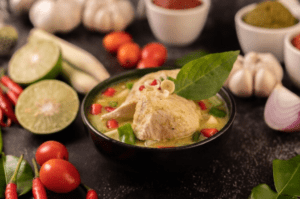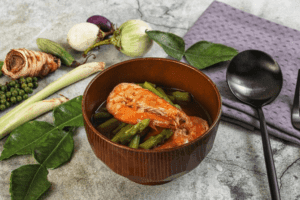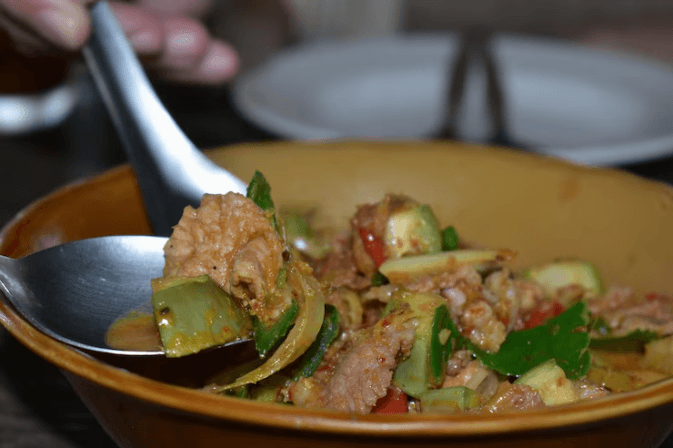What is Sinigang?
Sinigang Recipe is a Filipino dish known for its distinctive sour broth made with tamarind. A savory soup, sinigang offers the perfect balance of sour and umami flavors. It’s a dish that holds a special place in Filipino culture, often served as a comforting, family-style meal. While it originated as a humble, home-cooked dish, sinigang has become a symbol of Filipino cuisine enjoyed both locally and internationally. Its versatility is key to its popularity, as it can be made using a variety of proteins, vegetables, and souring agents.
Whether you’re new to Filipino food or a long-time fan, sinigang offers a taste of the Philippines’ rich culinary heritage. For those curious about other global comfort foods, check out this Dinner Recipes: A Culinary Adventure to explore diverse Dinner options.
The Origins of Sinigang Recipe
The origins of sinigang trace back to pre-colonial times, where sour stews made from native fruits were already a staple in Filipino households. Early versions of sinigang didn’t rely on tamarind but used local fruits such as bilimbi (kamias), green mangoes, or calamansi to create a tangy broth. Over time, tamarind became the more popular choice, known for its rich sourness and accessibility.
This dish is more than just a meal; it’s an important part of Filipino family life, often seen on the dinner table for special gatherings or casual family meals. Its popularity is also due to its adaptability: while the traditional version uses pork (meat), there are countless variations that use seafood, beef, and even tofu for a vegetarian option.
Why is Sinigang Recipe So Popular in the Philippines?
Sinigang is a go-to dish for Filipinos because it has everything they love in one bowl: a savory broth, tender proteins, hearty vegetables, and a refreshing tartness that makes it stand out. The balance of flavors, especially the sour taste, plays a key role in making it a favorite comfort food. It’s also flexible—whether you like your sinigang extra sour or with a light tang, you can adjust the flavor to your liking. Beyond taste, sinigang brings people together, encouraging conversations around the table with its delicious, wholesome flavors.
Ingredients for Sinigang Recipe
Main Protein Choices for Sinigang
Sinigang can be made with a variety of proteins. Here are the most common ones:
- Meat (typically belly or ribs)
Pork is the most traditional protein choice, with the rich, fatty cuts of belly or ribs providing depth and flavor to the broth. The meat tenderizes as it simmers in the sour broth, making each bite comforting and satisfying. - Shrimp (Sinigang na Hipon)
For a lighter version, sinigang na hipon is a popular choice. Shrimp adds a delicate flavor and cooks quickly, making it ideal for a fast yet delicious meal. - Milkfish (Sinigang na Bangus)
Bangus, or milkfish, is another fantastic option for sinigang. Its mild flavor pairs perfectly with the sour broth, and it’s often a favorite for those who prefer a less fatty alternative. - Other Proteins
While pork, shrimp, and milkfish are the most common, sinigang can also be made using other proteins such as beef, fish, and even chicken. Each type of protein offers its own distinct flavor profile.
Essential Vegetables in Sinigang Recipe
Vegetables are an essential part of sinigang, adding flavor, texture, and nutritional value. Here’s a list of the vegetables commonly used:
- Kangkong (water spinach)
One of the signature vegetables in sinigang, kangkong adds a leafy green crunch that complements the sourness of the broth. - Radish (labanos)
Sliced radishes are added to the broth, where they absorb the sourness and provide a mild, slightly sweet flavor that contrasts with the tangy broth. - Eggplant
Eggplant is another common addition to sinigang. When cooked, it becomes soft and absorbs the flavors of the broth, contributing to the dish’s overall depth. - String Beans (sitaw)
Sitaw, or string beans, bring a fresh, crisp texture to the dish, making each bite a delightful combination of soft and crunchy elements.
check out this Dinner Recipes: A Culinary Adventure to explore diverse Dinner options.

Souring Agents: Tamarind and Alternatives
- Tamarind (Sampalok)
Traditionally, tamarind is the main souring agent in sinigang. Its strong sourness balances the savory flavor of the meat and vegetables, creating the signature taste that people love. - Alternatives to Tamarind
While tamarind is the go-to for most sinigang recipes, there are other fruits and ingredients that can also bring sourness to the dish. Some alternatives include:- Calamansi (Filipino lime) – Offers a milder, citrusy tang.
- Green Mango – Adds a unique sourness, perfect for those who enjoy a fruity twist.
- Kamias (Bilimbi) – A small, sour fruit that’s often used in Filipino cooking.
For a more detailed look at tamarind’s health benefits, check out Tamarind and its health benefits.
How to Cook Sinigang Recipe: Step-by-Step Guide
Step 1: Prepare the Ingredients
Before you begin cooking, gather all the necessary ingredients:
- Cut the vegetables into manageable pieces.
- Portion your protein (whether it’s meat, shrimp, or fish).
- Prepare your souring agent, whether it’s tamarind or another substitute.
Step 2: Make the Broth
- In a large pot, bring water or broth to a boil.
- Once the water is boiling, add your souring agent and let it dissolve. If you’re using tamarind, you can boil the whole tamarind pods in the water, or use a tamarind paste for convenience.
- Allow the broth to simmer for 20-30 minutes, letting the sourness fully develop.
Step 3: Add the Protein and Vegetables
- Once the broth has achieved the desired tanginess, add your protein (whether it’s meat, shrimp, or fish). Let it cook until tender.
- Start adding your vegetables, beginning with the ones that take longer to cook, such as radish and eggplant.
- As the vegetables cook, keep tasting the broth. Adjust the seasoning with fish sauce, salt, or pepper to bring out the flavors.
Tips for a Perfect Sinigang Recipe
Balancing the Sourness
Achieving the perfect balance of sourness in sinigang can be tricky, especially since the souring agent can vary in strength. Here’s how to balance it:
- Add the souring agent slowly and taste along the way.
- If the broth becomes too sour, you can balance it out by adding more broth or a pinch of sugar.
Enhancing the Flavor with Side Dishes
While sinigang is a complete meal on its own, it’s often served with:
- Steamed rice – To absorb the savory broth.
- Fried fish or crispy tofu – For added texture and flavor.
How to Serve Sinigang
Filipino sinigang experience, garnish the dish with fresh herbs like green onions or cilantro, adding a burst of color and freshness. These herbs not only enhance the flavor but also bring an aromatic contrast to the tangy, sour broth. To complete your sinigang recipe, serve it alongside a bowl of steamed rice, which perfectly absorbs the broth and enhances the dish’s overall experience. The tender meat or seafood, combined with vibrant vegetables and the mouthwatering sour broth, creates a satisfying and comforting meal. Whether enjoyed for family gatherings or special occasions, sinigang is a beloved Filipino dish that provides both nourishment and warmth, making it a perfect addition to any meal.
Check ou this 10 serving hacks that will blow your guests mind.
Variations of Sinigang Recipe Across Regions
Regional Flavors and Techniques
Sinigang varies from region to region. Some areas might use other fruits, such as guava, to add a unique sweetness to the sour broth. Others might opt for coconut milk to create a creamier, richer version of the dish.
Modern Twists on the Classic Sinigang Recipe
In recent years, chefs have been experimenting with sinigang, offering new twists such as:
- Sinigang pizza – A fusion of Filipino and Italian flavors.
- Sinigang pasta – A unique take on combining two classic dishes into one.
Why Sinigang is a Healthy Dish
Nutritional Benefits of Ingredients
Sinigang is not only delicious but also packed with nutrients:
- Tamarind contains antioxidants that promote good health.
- The vegetables provide fiber and essential vitamins, and the lean proteins offer a source of energy without being too heavy.
How to Make Sinigang Recipe Healthier
- Swap out white rice for brown rice for added fiber.
- Use leaner cuts of meat or go for seafood or tofu for a lighter dish.
- Reduce the amount of fish sauce or salt for a healthier option.
Nutrition Table for Sinigang (per 1 serving)
| Nutrient | Amount | % Daily Value |
|---|---|---|
| Calories | 300 kcal | 15% |
| Protein | 20g | 40% |
| Carbohydrates | 25g | 8% |
| Fiber | 4g | 16% |
| Fat | 12g | 18% |
| Sodium | 600mg | 26% |
| Vitamin A | 25% of DV | 25% |
| Vitamin C | 30% of DV | 30% |
| Calcium | 6% of DV | 6% |
| Iron | 8% of DV | 8% |
Note: Nutritional values may vary based on the specific ingredients used (e.g., protein choice or portion size). The values above are estimates for a basic sinigang made with pork (meat), vegetables, and tamarind.For more details check the following link

FAQs About Sinigang Recipe
What is Sinigang Made Of?
Sinigang is a traditional Filipino dish made of a savory broth with a unique sour flavor, usually derived from tamarind. The dish typically features meat (like pork, beef, or shrimp), vegetables such as kangkong (water spinach), eggplant, radish, and string beans, and often includes other souring agents like calamansi (Filipino lime) or green mango. It’s a comforting soup that can be customized with various proteins and vegetables, making it a versatile and flavorful dish in Filipino cuisine.
Is Filipino Sinigang Healthy?
Yes, Filipino sinigang is a healthy dish, especially when made with lean proteins such as shrimp or fish. It’s rich in vitamins and minerals from the fresh vegetables like kangkong, radish, and eggplant. The souring agent, usually tamarind, is known for its antioxidants, which can help boost the immune system. Additionally, sinigang’s broth is low in fat, especially when made with lean meat or seafood. It’s a great source of hydration and provides a balance of nutrients, making it a wholesome meal option for all ages.
What Ingredients of Sinigang Are Mentioned in the Selection?
The sinigang recipe typically includes:
- Meat: Pork (belly or ribs), shrimp, or fish (like milkfish or bangus)
- Vegetables: Kangkong (water spinach), radish, eggplant, string beans, and sometimes tomatoes or okra
- Souring agents: Tamarind, calamansi (Filipino lime), green mango, or kamias (bilimbi)
- Seasonings: Fish sauce or salt for added umami flavor
These ingredients combine to create a rich, flavorful, and nutrient-packed soup, making sinigang a beloved Filipino dish worldwide.
What is the Difference Between Tom Yum and Sinigang?
While both Tom Yum and Sinigang are famous sour soups, they differ in several ways:
- Flavor: Tom Yum is a Thai soup with a strong, spicy, and sour flavor, often featuring lemongrass, lime leaves, and chili. Sinigang, on the other hand, is a Filipino dish known for its tangy, savory broth made primarily from tamarind, giving it a milder, earthier sourness.
- Ingredients: Tom Yum usually includes shrimp, mushrooms, and herbs like lemongrass and kaffir lime, while sinigang is more focused on a variety of vegetables like kangkong, eggplant, and radish, with meat (pork or fish) or seafood as the protein.
- Cultural Origins: Tom Yum comes from Thai cuisine, while sinigang is a staple in Filipino cuisine, highlighting the distinct culinary traditions of Southeast Asia.

Conclusion
Sinigang is more than just a meal—it’s a reflection of Filipino culture, a dish that brings people together. With its customizable flavors and nutritious ingredients, it’s no wonder that sinigang has become a beloved dish in Filipino households and beyond. Whether you’re enjoying it with meat, seafood, or vegetables, sinigang will always be a comforting bowl of happiness.





